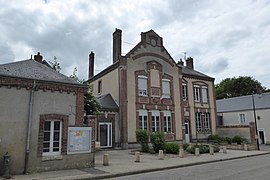Lumeau
Lumeau | |
|---|---|
 The town hall and school in Lumeau | |
| Coordinates: 48°07′00″N 1°47′11″E / 48.1167°N 1.7864°E | |
| Country | France |
| Region | Centre-Val de Loire |
| Department | Eure-et-Loir |
| Arrondissement | Châteaudun |
| Canton | Voves |
| Intercommunality | Beauce d'Orgères |
| Government | |
| • Mayor (2008–2014) | Charlie Peillon |
| Area 1 | 15.28 km2 (5.90 sq mi) |
| Population (2021)[1] | 136 |
| • Density | 8.9/km2 (23/sq mi) |
| Time zone | UTC+01:00 (CET) |
| • Summer (DST) | UTC+02:00 (CEST) |
| INSEE/Postal code | 28221 /28140 |
| Elevation | 120–134 m (394–440 ft) (avg. 123 m or 404 ft) |
| 1 French Land Register data, which excludes lakes, ponds, glaciers > 1 km2 (0.386 sq mi or 247 acres) and river estuaries. | |
Lumeau is a commune in the Eure-et-Loir department in northern France, between Chartres and Orléans.
Geography
Lumeau is situated in the Beauce agricultural plain, 34 km north from Orléans, 39 km north-east from Châteaudun, 50 km south of Chartres and 92 km south of Paris.
Geology and paleontology
The Beauce region is where lacustrine limestones were deposited from the Lutetian stratigraphic stage to the Aquitanian stage, on top of Cretaceous chalks. Spots of Orleanian sands from the Burdigalian stage appeared as well, and the whole region received wind-blown loess during Würm glaciation.
Since 1850, especially between 1883 et 1885 and notably in 1908, a large number of mammal fossils have been discovered in Orleanian sands in Lumeau (Burdigalian stage of Miocene). Most of them are displayed at the National Museum of Natural History (France), at the Muséum d'Orléans and at the Natural History Museum of Basel. Species discovered in the Orleanian sands at Lumeau include : teleoceras aurelianensis, mastodon turicensis, mastodon tapiroides, palaeomeryx kaupi, palaeomeryx, anchitherium aurelianensis, prolagus , steneofiber viciacensis, listriodon lockharti, hyotherium, palaeochoerus, pseudaelurus, genetta, ursidae, amphicyon, hyaenidae.
History
Hundreds of artifacts from the Paleolithic (Mousterian) and Mesolithic ages have been found in Lumeau. Several remains of early farmer settlements, tumuli, megalithes from the Neolithic age have been discovered and studied, with influence from both the Atlantic Bronze Age and urnfield culture. Strong expansion is correlated with La Tène culture.
Lumeau has roots as a Gaulish village in the Carnutes territory. It was inhabited long before Roman times. Its name derives from the Gallic elm (Ulmus) and is of Celtic origin. This is the region where a key uprising against the Romans occurred in January 52 BC during the Gallic Wars. The territory of Lumeau is crossed by two old Roman roads and includes a Roman villa with hypocaust and several farms.
The crossing of the Rhine in year 406 resulted in settlements of Vandals, Alemanni and Alans as foederati in the neighbourhoods of Lumeau and their later integration with the local population. Attila and the Huns marched towards Orleans in year 450 but the region was protected by Flavius Aetius' Roman army with Alan auxiliary troops and Salian Franks allies.
Merovingian tombs and artifacts were discovered in the outskirts of the village. Lumeau is cited in an Act of Charles the Bald (about AD 877). Lumeau has been part of the Crown lands of France since year 980.
In Neuvilliers hamlet of Lumeau, a tomb was discovered nearby a farm, including a gallery and a circular room used from the late antiquity to the 12th century, which are part of a very important network dating from the Middle Ages.
During the Hundred Years' War, especially in 1361, the British and Burgundians occupied the nearby castle. Thomas Montagu, 4th Earl of Salisbury and his army occupied Lumeau in July 1428 on his way to the siege of Orleans (1428-1429). Lumeau is in the northern neighbourhood of the battlefield of the Battle of Patay (18 June 1429).
During the French Wars of Religion, the church of Lumeau was burnt in 1562.
From 1785 to 1792 isolated farms suffered attacks from a criminal gang referred to as the 'Chauffeurs d'Orgères' (burners from Orgères).

During the Franco-Prussian War of 1870, Lumeau was in the middle of the Loigny-Poupry battlefield, between the French Armée de la Loire and the Bavarian and Prussian troops. The battle spread over the municipalities of Guillonville, Loigny, Lumeau and Poupry on 2 December 1870. Lumeau was mainly involved in combat events from November 29 to December 3, 1870, while further rescue activities took place from December 2, 1870 to February 18, 1871.
A memorial was built in 1873 in Neuvilliers hamlet where French troops were stationed. It is a white obelisk with a height of eight meters over an ossuary (containing thousands of human remains) under a granite basement surrounded by a chain.[citation needed]
Population
| Year | Pop. | ±% |
|---|---|---|
| 1793 | 484 | — |
| 1800 | 413 | −14.7% |
| 1851 | 501 | +21.3% |
| 1901 | 482 | −3.8% |
| 1946 | 320 | −33.6% |
| 1954 | 313 | −2.2% |
| 1962 | 267 | −14.7% |
| 1968 | 297 | +11.2% |
| 1975 | 229 | −22.9% |
| 1982 | 194 | −15.3% |
| 1990 | 179 | −7.7% |
| 1999 | 177 | −1.1% |
| 2008 | 187 | +5.6% |


Transport
The distances between Lumeau and its neighbouring towns are as follows:
- Loigny-la-Bataille 4 km
- Poupry 4 km
- Terminiers 5 km
- Artenay 8 km
- Road access from motorway A10 (8 km from exit 13), from roads N20/D2020, N&54/D954, D10, D3.9, D19
- Train station at Artenay: TER Centre-Val de Loire (line from Paris-Austerlitz to Orléans)
- Public transport: Transbeauce ligne 2 Orléans- Chartres
See also
References
- ^ "Populations légales 2021" (in French). The National Institute of Statistics and Economic Studies. 28 December 2023.



